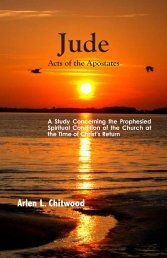Signs in John's Gospel - The Lamp Broadcast
Signs in John's Gospel - The Lamp Broadcast
Signs in John's Gospel - The Lamp Broadcast
Create successful ePaper yourself
Turn your PDF publications into a flip-book with our unique Google optimized e-Paper software.
Feed<strong>in</strong>g the Multitude 153<br />
When the Lord passed through the land of Egypt at midnight,<br />
He looked for one th<strong>in</strong>g alone. He looked for the blood of sla<strong>in</strong> lambs<br />
on the doorposts and l<strong>in</strong>tel of the houses.<br />
If the Lord saw the blood, He knew that the firstborn had already<br />
died <strong>in</strong> that house. And the Lord passed over that house, for He was<br />
satisfied. If there was no blood, there was no <strong>in</strong>dication that the<br />
firstborn had died. And the Lord then slew the firstborn Himself, for<br />
death had been decreed upon all the firstborn. <strong>The</strong> firstborn must<br />
die, either via a substitute or apart from a substitute.<br />
“Christ” is the Passover Lamb, and Israel has sla<strong>in</strong> this Lamb.<br />
But the nation, God’s firstborn son, has yet to apply the blood.<br />
<strong>The</strong> Passover, the first of the festivals, po<strong>in</strong>ts to that future day<br />
when Christ returns, the nation looks upon the One Whom they<br />
slew, they recognize that which has been done, and they then,<br />
through faith, appropriate the blood (cf. Ex. 11:4, 5; 12:3ff; Isa.<br />
53:4-6; Zech. 12:10-14; 13:6).<br />
<strong>The</strong> Passover foreshadows Israel’s national conversion at the<br />
time of Christ’s return. Only after a nation has been born <strong>in</strong> a day<br />
(Isa. 66:8) can those th<strong>in</strong>gs foreshadowed by the rema<strong>in</strong><strong>in</strong>g six<br />
festivals occur. Only after the Passover has been fulfilled (and, <strong>in</strong><br />
reality, the subsequent six festivals as well) can that foreshadowed<br />
by the fourth sign <strong>in</strong> John’s gospel occur.<br />
<strong>The</strong> Loaves and Fish<br />
<strong>The</strong> fourth sign <strong>in</strong> John’s gospel has to do with a miraculous<br />
multiplication of five barley loaves and two small fish which a<br />
lad had <strong>in</strong> his possession. And the multiplication of this small<br />
quantity of food was enough to feed both the disciples and the<br />
multitude, with twelve baskets of food left over after the rema<strong>in</strong><strong>in</strong>g<br />
fragments had been gathered.<br />
Key <strong>in</strong>formation necessary for properly understand<strong>in</strong>g the sign,<br />
with<strong>in</strong> its contextual sett<strong>in</strong>g (as it is <strong>in</strong>troduced through referr<strong>in</strong>g<br />
to a mounta<strong>in</strong> and to the nearness of the Passover [vv. 3, 4]), is given<br />
later <strong>in</strong> the chapter when <strong>in</strong>quiry perta<strong>in</strong><strong>in</strong>g to the sign is made<br />
by some compris<strong>in</strong>g the multitude.<br />
Note verses twenty-six and twenty-seven <strong>in</strong> this respect:



